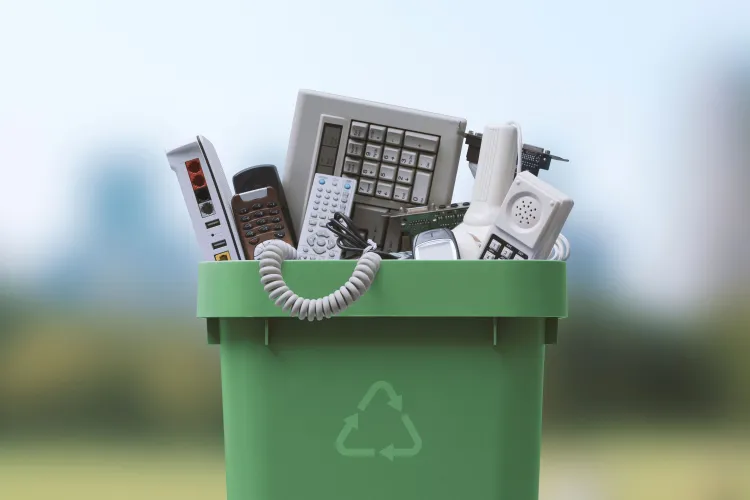Electronic waste (e-waste) is one of the fastest-growing types of waste in the world. With the rapid development of technology and the constant introduction of new products, many electronic devices are quickly discarded or replaced. The rise of a large number of old electronic products has caused enormous problems for the earth. E-waste contains hazardous chemicals such as lead, mercury, and cadmium, which can pollute the air, water, and soil if not properly disposed of. Incorrect recycling of e-waste also means the loss of important materials such as gold, silver, and copper. Recognizing the importance of reducing e-waste is essential for promoting a cleaner and healthier world and encouraging the long-term use of technological products.
Choose Durable and Easy to Repair Electronic Products
Buying technological products that are durable and easy to repair is one of the best ways to reduce e-waste. When purchasing new technological products, look for products that are durable and easy to repair. You can get the most out of your tools if they are modular, have replaceable batteries, and have easily accessible parts. Avoiding popular or cheap products that break easily can reduce the frequency of discarding and buying new ones. Supporting brands that offer repair services or spare parts can also encourage manufacturers to use more environmentally friendly production methods, giving consumers more sustainable products.
How to Make Your Devices Last as Long as Possible
To reduce the amount of e-waste, it is important to take good care of your electronics. Simple habits like keeping your device in a protective case, protecting it from extreme temperatures, and cleaning it regularly can keep your device running smoothly and prevent damage. Keeping your software up to date can also make your device safer, more efficient, and longer-lasting. If an electronic device starts to show signs of wear, you may need to repair or upgrade the parts instead of buying a brand new one. By making your electronics last as long as possible, you can reduce the demand for new products and reduce waste.
Use and Donate Old Electronics
Instead of throwing away your old electronics, consider reusing or donating them. Someone else may find value in them. Many groups, schools, and community centers take these electronics so that those who need them can use technology. Recycling electronics not only keeps them out of landfills, but it also encourages everyone to use technology and closes the technology gap. You can donate electronics that you no longer need to extend their lifespan. This can also reduce the amount of e-waste. Promoting reuse in your community can foster a culture of sharing that benefits everyone.
Recycle Electronics Properly
When electronics fail, they need to be recycled properly so that e-waste is disposed of in an environmentally friendly way. Recycling electronics safely removes valuable components and minimizes the amount of hazardous materials that harm the planet. You can drop off old electronics at many stores and locations that offer e-waste recycling programs. It’s important to choose a certified, environmentally friendly recycler. Don’t throw electronics in the trash, as this often results in toxic chemicals being released into the environment. Smart recycling helps recover valuable resources and reduce pollution.
Buy Used or Refurbished Electronics
A smart way to reduce e-waste and keep usable electronics is to buy used or refurbished products. Refurbished products are inspected, repaired if necessary, and worked on to ensure they meet quality standards. They often come with a warranty. Buying used electronics reduces the demand for new products and extends the life of old ones. It’s also often less expensive, allowing more people to use tech products. Creating a circular economy in tech, where products are reused instead of thrown away, is easier when the used and refurbished market is supported.
Reducing Consumption and Practicing Minimalism
One of the best ways to reduce e-waste is to use your electronics less often. Minimalism, or buying only what you really need, can help you get rid of a lot of electronics. Don’t feel obligated to buy new electronics just because new ones are on the market. Instead, take good care of your electronics and use them while they still work. Knowing how often you use them can lead to more eco-friendly habits and reduce the environmental damage caused by manufacturing, transporting, and disposing of electronics. A cleaner lifestyle with technology is based on choosing quality over quantity.
Disposing of Batteries and Other Accessories
Batteries and electronic components such as chargers and cables are often overlooked when it comes to e-waste, but they can make the problem worse. Batteries, especially lithium-ion batteries, contain hazardous chemicals that require specific disposal methods. Many stores and recycling centers offer programs for the safe disposal of batteries and accessories. Do not dispose of these in regular trash or recycling bins; this can cause fires or contamination. Carefully sorting and recycling these items can make waste management safer and benefit the environment.
Helping Businesses Implement Eco-friendly Practices
People can make a difference in the tech industry by purchasing products from companies that are committed to the environment. Many companies are working to reduce their environmental impact by using eco-friendly materials, reducing the energy consumption of their products, and launching recycling programs. Buying products from eco-friendly companies can encourage the industry to adopt greener practices and come up with better solutions. Before you buy, understanding a brand’s environmental policies and certifications can help you make smart choices that reduce e-waste.
Conclusion
To reduce e-waste, people need to be more aware of how often they use their technology products, dispose of them properly, and support eco-friendly technology use. We can significantly reduce the negative impact of e-waste by choosing sustainable electronics, extending their lifespan, reusing and donating old electronics, and recycling them properly. Buying used products and reducing unnecessary technology use are two other ways to protect the environment. Properly disposing of batteries and accessories and buying products from companies that care about the environment can help the tech industry make greener choices. By educating others and ourselves about e-waste, we can raise awareness and take action to achieve a cleaner tech lifestyle. All of this contributes to a better world and a more stable future for every tech user.
FAQs
1. What is e-waste?
E-waste refers to electronic products such as mobile phones, computers, TVs, and accessories that are thrown away because they are no longer needed or useful.
2. What are the dangers of e-waste?
E-waste contains harmful chemicals that can be harmful to the planet and human health if not disposed of properly.
3. How can I make my devices last longer?
By taking good care of your devices, repairing them when possible, and keeping the software up to date, you can extend their lifespan.
4. Where can I drop off old electronics?
Many local governments, retailers, and certified recyclers offer e-waste recycling programs.
5. Can I trust used equipment?
Yes, refurbished equipment is inspected and repaired to ensure it meets quality standards. It usually comes with a warranty.




